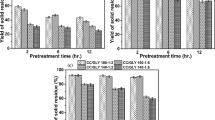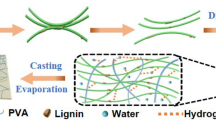Abstract
Herein for the first time, lignocellulose nanofibrils (LCNF) were prepared from pine-wood powder using microwave (MW)-assisted deep eutectic solvent (DES) pretreatment coupled with high-pressure homogenization. A DES based on choline chloride and lactic acid was employed, and LCNFs prepared by conventional DES pretreatment at 110 °C (LCNF-110) and 130 °C (LCNF-130) were used for comparison. Although MW treatment offered a high removal of lignin (70%) and hemicellulose (90%) within a short time (110 s), the morphological observations by scanning and transmission electron microscopies revealed excellent nanofibrillation of the conventionally heat-treated samples. Likewise, LCNF-110 and LCNF-130 exhibited high tensile strengths of 154.6 ± 5.0 and 136.8 ± 1.2 MPa, respectively, whereas that of LCNF-MW was only 75.6 ± 1.4 MPa. Interestingly, LCNF-MW with a lignin content between that of LCNF-110 and LCNF-130 exhibited high thermal stability (Tmax 309.6 °C) and potent antioxidant properties. However, the lignin contents of the LCNFs determined their UV-radiation blocking efficiency, where LCNF-110 > LCNF-MW > LCNF-130. Furthermore, all LCNF films exhibited good visible-light transparency, flexibility, and water contact angles (> 87°), indicating their promising potential for packaging applications.








Similar content being viewed by others
Data availability
The authors confirm that the data supporting the findings of this study are available within the article and supporting information.
References
Abbott AP, Capper G, Davies DL et al (2003) Novel solvent properties of choline chloride/urea mixtures. Chem Commun 58:70–71. https://doi.org/10.1039/b210714g
Aguilar-Reynosa A, Romaní A, Rodríguez-Jasso MR et al (2017) Microwave heating processing as alternative of pretreatment in second-generation biorefinery: an overview. Energy Convers Manag 136:50–65. https://doi.org/10.1016/j.enconman.2017.01.004
Alvarez-Vasco C, Ma R, Quintero M et al (2016) Unique low-molecular-weight lignin with high purity extracted from wood by deep eutectic solvents (DES): a source of lignin for valorization. Green Chem 18:5133–5141. https://doi.org/10.1039/c6gc01007e
Bayer IS (2020) Superhydrophobic coatings from ecofriendly materials and processes: a review. Adv Mater Interfaces 7:1–25. https://doi.org/10.1002/admi.202000095
Bian H, Chen L, Dong M et al (2021) Natural lignocellulosic nanofibril film with excellent ultraviolet blocking performance and robust environment resistance. Int J Biol Macromol 166:1578–1585. https://doi.org/10.1016/j.ijbiomac.2020.11.037
Chen Z, Bai X, Lusi A, Wan C (2018) High-solid lignocellulose processing enabled by natural deep eutectic solvent for lignin extraction and industrially relevant production of renewable chemicals. ACS Sustain Chem Eng 6:12205–12216. https://doi.org/10.1021/acssuschemeng.8b02541
Dong H, Zheng L, Yu P et al (2020) Characterization and application of lignin-carbohydrate complexes from lignocellulosic materials as antioxidants for scavenging in vitro and in vivo reactive oxygen species. ACS Sustain Chem Eng 8:256–266. https://doi.org/10.1021/acssuschemeng.9b05290
Espinosa E, Bascón-Villegas I, Rosal A et al (2019) PVA/(ligno)nanocellulose biocomposite films. Effect of residual lignin content on structural, mechanical, barrier and antioxidant properties. Int J Biol Macromol 141:197–206. https://doi.org/10.1016/j.ijbiomac.2019.08.262
Ewulonu CM, Liu X, Wu M, Huang Y (2019) Ultrasound-assisted mild sulphuric acid ball milling preparation of lignocellulose nanofibers (LCNFs) from sunflower stalks (SFS). Cellulose 26:4371–4389. https://doi.org/10.1007/s10570-019-02382-4
Farooq M, Zou T, Riviere G et al (2019) Strong, ductile, and waterproof cellulose nanofibril composite films with colloidal lignin particles. Biomacromol 20:693–704. https://doi.org/10.1021/acs.biomac.8b01364
Francisco M, van den Bruinhorst A, Kroon MC (2012) New natural and renewable low transition temperature mixtures (LTTMs): screening as solvents for lignocellulosic biomass processing. Green Chem 14:2153. https://doi.org/10.1039/c2gc35660k
Gu L, Jiang B, Song J et al (2019) Effect of lignin on performance of lignocellulose nanofibrils for durable superhydrophobic surface. Cellulose 26:933–944. https://doi.org/10.1007/s10570-018-2129-0
Herrera M, Thitiwutthisakul K, Yang X et al (2018) Preparation and evaluation of high-lignin content cellulose nanofibrils from eucalyptus pulp. Cellulose 25:3121–3133. https://doi.org/10.1007/s10570-018-1764-9
Hong S, Shen XJ, Xue Z et al (2020a) Structure-function relationships of deep eutectic solvents for lignin extraction and chemical transformation. Green Chem 22:7219–7232
Hong S, Song Y, Yuan Y et al (2020) Production and characterization of lignin containing nanocellulose from luffa through an acidic deep eutectic solvent treatment and systematic fractionation. Ind Crops Prod 143:111913. https://doi.org/10.1016/j.indcrop.2019.111913
Huang J, Li M, Lu Y et al (2021) A facile preparation of superhydrophobic L-CNC-coated meshes for oil-water separation. RSC Adv 11:13992–13999. https://doi.org/10.1039/d1ra02291a
Impoolsup T, Chiewchan N, Devahastin S (2020) On the use of microwave pretreatment to assist zero-waste chemical-free production process of nanofibrillated cellulose from lime residue. Carbohydr Polym 230:115630. https://doi.org/10.1016/j.carbpol.2019.115630
Ji Q, Yu X, Yagoub AEGA et al (2021) Efficient cleavage of strong hydrogen bonds in sugarcane bagasse by ternary acidic deep eutectic solvent and ultrasonication to facile fabrication of cellulose nanofibers. Cellulose 28:6159–6182. https://doi.org/10.1007/s10570-021-03876-w
Kumar AK, Parikh BS, Pravakar M (2016) Natural deep eutectic solvent mediated pretreatment of rice straw: bioanalytical characterization of lignin extract and enzymatic hydrolysis of pretreated biomass residue. Environ Sci Pollut Res 23:9265–9275. https://doi.org/10.1007/s11356-015-4780-4
Kwon GJ, Yang BS, Park CW et al (2020) Treatment effects of choline chloride-based deep eutectic solvent on the chemical composition of red pine (Pinus densiflora). BioResources 15:6457–6470. https://doi.org/10.15376/biores.8.3.6457-6470
Kwon GJ, Bandi R, Yang BS et al (2021) Choline chloride based deep eutectic solvents for the lignocellulose nanofibril production from Mongolian oak (Quercus mongolica). Cellulose 28:9169–9185. https://doi.org/10.1007/s10570-021-04102-3
Liu Y, Chen W, Xia Q et al (2017a) Efficient cleavage of lignin-carbohydrate complexes and ultrafast extraction of lignin oligomers from wood biomass by microwave-assisted treatment with deep eutectic solvent. Chemsuschem 10:1692–1700. https://doi.org/10.1002/cssc.201601795
Liu Y, Guo B, Xia Q et al (2017b) Efficient cleavage of strong hydrogen bonds in cotton by deep eutectic solvents and facile fabrication of cellulose nanocrystals in high yields. ACS Sustain Chem Eng 5:7623–7631. https://doi.org/10.1021/acssuschemeng.7b00954
Liu Q, Yuan T, Fu Q et al (2019a) Choline chloride-lactic acid deep eutectic solvent for delignification and nanocellulose production of moso bamboo. Cellulose 26:9447–9462. https://doi.org/10.1007/s10570-019-02726-0
Liu Y, Nie Y, Lu X et al (2019b) Cascade utilization of lignocellulosic biomass to high-value products. Green Chem 21:3499–3535. https://doi.org/10.1039/C9GC00473D
Liu C, Li MC, Chen W et al (2020) Production of lignin-containing cellulose nanofibers using deep eutectic solvents for UV-absorbing polymer reinforcement. Carbohydr Polym 246:116548. https://doi.org/10.1016/j.carbpol.2020.116548
Liu C, Li Z, Li MC et al (2022) Lignin-containing cellulose nanofibers made with microwave-aid green solvent treatment for magnetic fluid stabilization. Carbohydr Polym 291:119573. https://doi.org/10.1016/j.carbpol.2022.119573
Liu C, Zhou G, Li Z et al (2022) Lignin-containing cellulose nanomaterials produced by microwave-assisted deep eutectic solvent treatment as rheology modifiers for fracturing fluids. Ind Crops Prod 187:115402. https://doi.org/10.1016/j.indcrop.2022.115402
Lynam JG, Kumar N, Wong MJ (2017) Deep eutectic solvents’ ability to solubilize lignin, cellulose, and hemicellulose; thermal stability; and density. Bioresour Technol 238:684–689. https://doi.org/10.1016/j.biortech.2017.04.079
Manoharan K, Bhattacharya S (2019) Superhydrophobic surfaces review: functional application, fabrication techniques and limitations. J Micromanufacturing 2:59–78. https://doi.org/10.1177/2516598419836345
Moubarik A, Grimi N, Boussetta N (2013) Structural and thermal characterization of Moroccan sugar cane bagasse cellulose fibers and their applications as a reinforcing agent in low density polyethylene. Compos Part B Eng 52:233–238. https://doi.org/10.1016/j.compositesb.2013.04.040
Nair SS, Yan N (2015a) Effect of high residual lignin on the thermal stability of nanofibrils and its enhanced mechanical performance in aqueous environments. Cellulose 22:3137–3150. https://doi.org/10.1007/s10570-015-0737-5
Nair SS, Yan N (2015b) Bark derived submicron-sized and nano-sized cellulose fibers: from industrial waste to high performance materials. Carbohydr Polym 134:258–266. https://doi.org/10.1016/j.carbpol.2015.07.080
Peng Y, Nair SS, Chen H et al (2018) Effects of lignin content on mechanical and thermal properties of polypropylene composites reinforced with micro particles of spray dried cellulose nanofibrils. ACS Sustain Chem Eng 6:11078–11086. https://doi.org/10.1021/acssuschemeng.8b02544
Rojo E, Peresin MS, Sampson WW et al (2015) Comprehensive elucidation of the effect of residual lignin on the physical, barrier, mechanical and surface properties of nanocellulose films. Green Chem 17:1853–1866. https://doi.org/10.1039/c4gc02398f
Sánchez-Gutiérrez M, Espinosa E, Bascón-Villegas I et al (2020) Production of cellulose nanofibers from olive tree harvest—A residue with wide applications. Agronomy 10:696. https://doi.org/10.3390/agronomy10050696
Satlewal A, Agrawal R, Bhagia S et al (2018) Natural deep eutectic solvents for lignocellulosic biomass pretreatment: recent developments, challenges and novel opportunities. Biotechnol Adv 36:2032–2050. https://doi.org/10.1016/j.biotechadv.2018.08.009
Shen XJ, Wen JL, Mei QQ et al (2019) Facile fractionation of lignocelluloses by biomass-derived deep eutectic solvent (DES) pretreatment for cellulose enzymatic hydrolysis and lignin valorization. Green Chem 21:275–283. https://doi.org/10.1039/c8gc03064b
Simpson JT, Hunter SR, Aytug T (2015) Superhydrophobic materials and coatings: a review. Reports Prog Phys. https://doi.org/10.1088/0034-4885/78/8/086501
Sirviö JA, Visanko M, Liimatainen H (2015) Deep eutectic solvent system based on choline chloride-urea as a pre-treatment for nanofibrillation of wood cellulose. Green Chem 17:3401–3406. https://doi.org/10.1039/c5gc00398a
Sirviö JA, Ismail MY, Zhang K et al (2020) Transparent lignin-containing wood nanofiber films with UV-blocking, oxygen barrier, and anti-microbial properties. J Mater Chem A 8:7935–7946. https://doi.org/10.1039/c9ta13182e
Sluiter A, Hames B, Ruiz R, Scarlata C, Sluiter J, Templeton D, Crocker D (2008) Determination of Structural Carbohydrates and Lignin in Biomass: Laboratory Analytical Procedure (LAP); Issue Date: April 2008; Revision Date: July 2011 (Version 07–08–2011) - 42618.pdf. Tech Rep NREL/ TP -510 -42618 1–15
Smith EL, Abbott AP, Ryder KS (2014) Deep eutectic solvents (DESs) and their applications. Chem Rev 114:11060–11082
Song Y, Xu Y, Li D et al (2021) Sustainable and superhydrophobic lignocellulose-based transparent films with efficient light management and self-cleaning. ACS Appl Mater Interfaces 13:49340–49347. https://doi.org/10.1021/acsami.1c14948
Trovagunta R, Zou T, Österberg M et al (2021) Design strategies, properties and applications of cellulose nanomaterials-enhanced products with residual, technical or nanoscale lignin—A review. Carbohydr Polym 254:117480. https://doi.org/10.1016/j.carbpol.2020.117480
Wang Q, Du H, Zhang F et al (2018) Flexible cellulose nanopaper with high wet tensile strength, high toughness and tunable ultraviolet blocking ability fabricated from tobacco stalk: via a sustainable method. J Mater Chem A 6:13021–13030. https://doi.org/10.1039/c8ta01986j
Wang H, Li J, Zeng X et al (2020) Extraction of cellulose nanocrystals using a recyclable deep eutectic solvent. Cellulose 27:1301–1314. https://doi.org/10.1007/s10570-019-02867-2
Wen Y, Yuan Z, Liu X et al (2019) Preparation and characterization of lignin-containing cellulose nanofibril from poplar high-yield pulp via TEMPO-mediated oxidation and homogenization. ACS Sustain Chem Eng 7:6131–6139. https://doi.org/10.1021/acssuschemeng.8b06355
Xiao L, Liu W, Huang J et al (2021) Study on the antioxidant activity of lignin and its application performance in SBS elastomer. Ind Eng Chem Res 60:790–797. https://doi.org/10.1021/acs.iecr.0c04699
Xie J, Xu J, Zhang Z et al (2023) New ternary deep eutectic solvents with cycle performance for efficient pretreated radiata pine forming to lignin containing cellulose nanofibrils. Chem Eng J 451:138591. https://doi.org/10.1016/j.cej.2022.138591
Yang H, Yan R, Chen H et al (2007) Characteristics of hemicellulose, cellulose and lignin pyrolysis. Fuel 86:1781–1788. https://doi.org/10.1016/j.fuel.2006.12.013
Zdanowicz M, Wilpiszewska K, Spychaj T (2018) Deep eutectic solvents for polysaccharides processing. A review. Carbohydr Polym 200:361–380
Acknowledgments
This research was supported by the Basic Science Research Program through the National Research Foundation of Korea (NRF), funded by the Ministry of Education (No. 2018R1A6A1A03025582).
Funding
This research was supported by the Basic Science Research Program through the National Research Foundation of Korea (NRF), funded by the Ministry of Education (No. 2018R1A6A1A03025582).
Author information
Authors and Affiliations
Contributions
G-J.K: Conceptualization, Methodology, Writing—original draft; S-W.C: Investigation, Methodology, Data curation; R.B: Writing—Review and editing; B-S.Y: Methodology, Data curation; R.D: Data curation; S-Y.H: Re-sources, Project Administration; S-Y.M: Methodology, Data curation; J-K.K: Data curation, visualization; N-H.K: Supervision; S-H.L: Supervision, Funding acquisition.
Corresponding author
Ethics declarations
Conflict of interest
The authors have no relevant financial or non-financial interests to disclose.
Additional information
Publisher's Note
Springer Nature remains neutral with regard to jurisdictional claims in published maps and institutional affiliations.
Supplementary Information
Below is the link to the electronic supplementary material.
Rights and permissions
Springer Nature or its licensor (e.g. a society or other partner) holds exclusive rights to this article under a publishing agreement with the author(s) or other rightsholder(s); author self-archiving of the accepted manuscript version of this article is solely governed by the terms of such publishing agreement and applicable law.
About this article
Cite this article
Kwon, GJ., Cho, SW., Bandi, R. et al. Production of lignocellulose nanofibrils by conventional and microwave-assisted deep-eutectic-solvent pretreatments: mechanical, antioxidant, and UV-blocking properties. Cellulose 30, 4277–4292 (2023). https://doi.org/10.1007/s10570-023-05164-1
Received:
Accepted:
Published:
Issue Date:
DOI: https://doi.org/10.1007/s10570-023-05164-1




